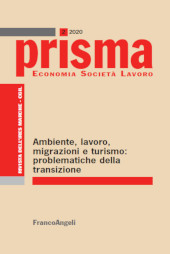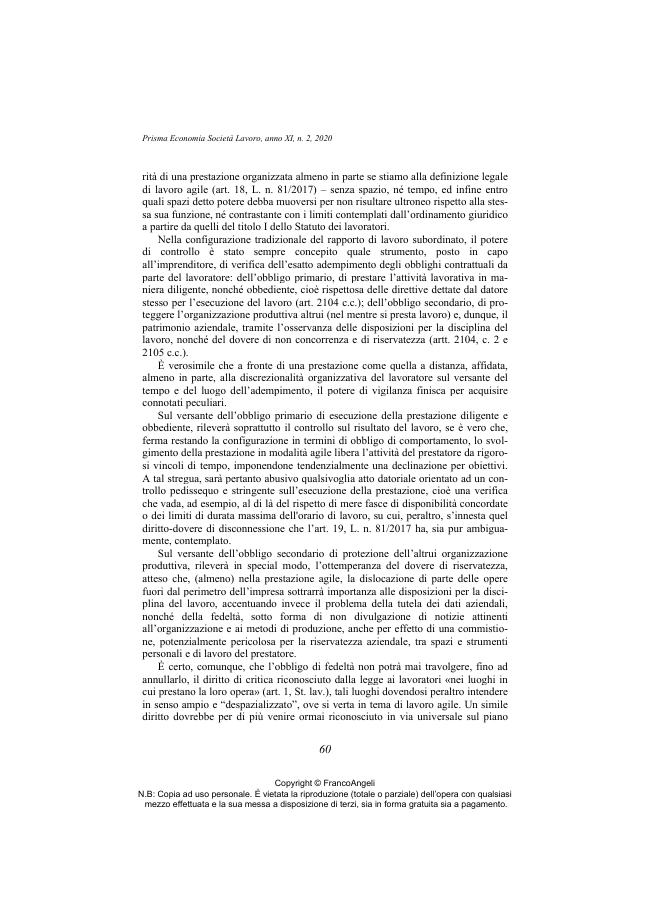2020 - Franco Angeli
Articolo
Versione Digitale
Download | Copia/incolla | Stampa
Comando e controllo nel lavoro agile : prime riflessioni
52-67 p.
- La normativa italiana in materia di lavoro agile (L. n. 81 del 2017) delinea le caratteristiche di una nuova modalità di lavoro flessibile, senza vincoli specifici di orario e luogo di lavoro. L'istituto, che nasce con finalità di incrementare la competitività e agevolare la conciliazione dei tempi di vita e di lavoro, solleva questioni nuove, concernenti tanto l'organizzazione e la produttività del lavoro, quanto il benessere dei lavoratori, aprendo nuovi spazi di riflessione e di studio a riguardo. Alla luce di queste prime considerazioni, il contributo in oggetto si concentra sull'impatto del lavoro agile, e più in generale del lavoro a distanza, nei confronti dei poteri tipici del datore di lavoro rispetto alle relazioni industrialitipo. Con l'introduzione di nuove tecnologie e di nuovi modelli di organizzazione del lavoro, il potere di controllo del datore di lavoro tende a rafforzarsi, esponendo i lavoratori a nuove forme di sorveglianza costante.
- In questo (nuovo) contesto, ci si chiede, in particolare, in che modo il potere di controllo o vigilanza si atteggi nel lavoro a distanza, quale funzione sia deputato ad assolvere e se e in che misura risulti compatibile con la disciplina avente ad oggetto la vigilanza sull'esatto adempimento degli obblighi contrattuali da parte dei dipendenti di cui all'art. 4 St. lav. Analogamente, ci si chiede quali siano gli effetti della flessibilità dell'orario di lavoro sul potere, sui doveri e sulle responsabilità del datore, chiamato a garantire la disconnessione del lavoratore dagli strumenti tecnologici di lavoro attraverso l'adozione di apposite misure tecniche e organizzative (art. 19, co. 1, L. 81/2017).
- D'altro canto, lo scopo del diritto alla disconnessione non è solo quello di tutelare la salute del lavoratore e garantire il rispetto della sua vita personale, ma anche quello di evitare il rischio di abuso di potere del datore di lavoro, comunemente definito "time porosity". Tuttavia, un modo adeguato per garantire efficacemente il diritto del lavoratore alla disconnessione non è ancora stato individuato e la questione merita di essere approfondita. Tenuto conto di ciò, sarebbe opportuno ripensare al ruolo, da una parte, della contrattazione collettiva e delle parti sociali e, dall'altra, della legge nell'ottica di innalzare la qualità del lavoro a distanza. [Testo dell'editore].
- The Italian regulative framework on remote working (Law No. 81 of 2017) outlines the features of a new flexible work arrangement, without specific constraints in terms of time and place of work. Despite the fact that it is based on a standard employment contract, the flexible and dynamic management of both "times" and "spaces" is left to an agreement between the employer and the employee. This modality seems to overcome the Fordist paradigm and the traditional core of standard worker protections. Although remote working was originally born as a way to promote worklife balance and to enhance competitiveness, it currently raises concerns in terms of its organization, as well as the productivity of workers and their wellbeing, thus offering both new opportunities and new challenges. Given these considerations, the contribution focuses on the impact of remote working on the current employer's role and powers, according to the standard employment relationship.
- The introduction of new technologies and new models of work organization gives the employer new tools to monitor and control the workers, exposing the employees to new forms of constant surveillance, including their performance and their compliance with the overall work organization at all times. In this context, how Article 4 of the Statute of Workers on monitoring work from a distance might be applied to remote work is an open question. Additionally, the effects of flexible working time arrangements in relation to the employers' power, duties and responsibilities need to be explored: while wielding this power, they are asked to respect rest times (breaks) and to comply with the technical and organizational measures necessary to ensure the disconnection of the worker from the technological instruments of work (art. 19, co. 1, L. 81/2017).
- The purpose of the right to disconnect is not only to protect the worker's health and ensure respect for their personal life, but also to avoid the risk of employer's power abuse, commonly referred to as "time porosity". However, a proper way to guarantee effectively the worker's right to disconnect is still to be found and this matter needs examining in further depth. Certainly, this right is linked to the occupational health and safety rights of the workers, including the protection of their physical and mental integrity. In a way, the right to disconnect has to be considered equivalent to the right to rest and leisure, with the novelty of a remote technological context.
- As a result, it is the employer's duty to protect the health, safety and welfare of their employees, also when working remotely. The implications of the "anytime, anywhere" nature of remote work can also result in a risk of different spheres of life overlapping, with boundaries between personal and work time becoming feeble. While the law of 2017 is considering remote work as a "conciliatory tool" for work life balance, the increasing fragmentation of the remote activities not only in terms of space, but also in terms of time, has exacerbated the risks aforementioned. Given these circumstances, it is fundamental to discuss the role of collective bargaining and social partners in improving the quality of remote working. [Publisher's text].
Fa parte di
Prisma : economia, società, lavoro : 2, 2020-
Informazioni
Codice DOI: 10.3280/PRI2020-002004
ISSN: 2036-5063
PAROLE CHIAVE
- lavoro da remoto, potere di controllo, art 4 Statuto dei Lavoratori, diritto di disconnessione, time porosity, remote working, employers' power, article 4 of the Statute of Workers, right to disconnection, time porosity
-
Nello stesso fascicolo
- Editoriale
- La comunicazione pubblica dell'immigrazione "prima e dopo" la pandemia : uno studio di caso locale
- "Destinazione Marche" : politiche turistiche e viaggi per le famiglie (prima dell'epidemia da Covid-19)
- Comando e controllo nel lavoro agile : prime riflessioni
- Le bonifiche delle discariche in procedura di infrazione UE : criticità, infiltrazioni criminali e proposte di policy
- Giacomo Brodolini e lo Statuto dei lavoratori
- "Anni difficili : i licenziamenti in Italia in tempi di crisi" di Stefano Giubboni (Giappichelli, 2020)
- Autori/Autrici



